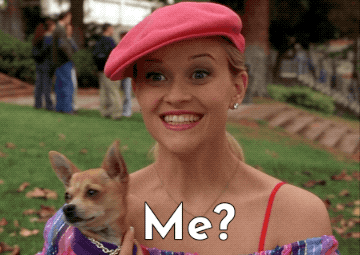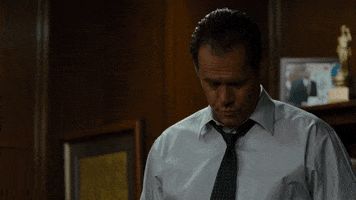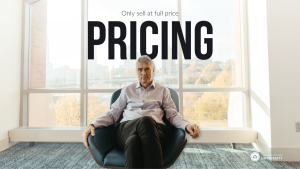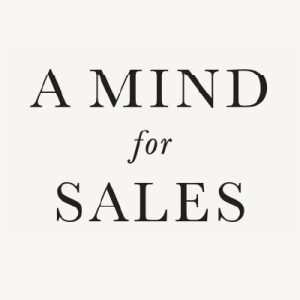The price a customer will pay is a reflection of the value you create.
When learning about your prospect becomes knowing your customer, you can customize that value.
There are six things you should know and have in your prospecting tool belt before you present your next price.
Like today’s sneak peek? Get the full Pricing Masterclass here, I’ve got plenty for you to learn, and perhaps unlearn about how to get full price and stop discounting.
1. Your confidence impacts the price.
Never allow a price to go out the door without legs being attached to it. In other words, allow your human presence to do the work. Don’t sit there and think, “Well, I’m not sure if they’re going to take it, so I’m just going to email it to them and feel them out.” No, that’s bad.
Instead, communicate your price eyeball to eyeball. That means if you have a meeting set up with them, you don’t send that proposal until 30 seconds before that meeting is scheduled to begin.
Don’t allow your customer to see your proposal without seeing you at the same time.
Your confidence is going to determine the price you get. If you don’t believe in your own price, how do you expect your customer to believe in it? They won’t.
Read more about 5 Pricing Rules I Wish I’d Known Earlier.
2. Value must exceed price.
If you’ve done your homework in the selling process, you’ve uncovered benefits that they’re looking for. You have discovered the needs that they have and the outcomes that they’re looking for. In addition, you have really been able to quantify and qualify them as to what they’re worth. And the sum of those values has to exceed the price.
Because remember this: customers don’t buy, they invest. When I know that I’ve got so much value in this proposal that it exceeds the price, then I’m good to go.
3. Know the value of time and money.
Money means different things to different people. Time means different things to different people. You have to understand both. If you don’t, then you’re in a world of hurt.
If you create enough value, you can link it to time. In other words, if the customer doesn’t put your product or service into practice now, guess what? They’re not going to reap the rewards.
What’s that going to cost them?
How much is that going to cost them?
These kinds of questions to the customer are linking time and money. Other elements to consider: Is this part of their capital expenditures? Is this a routine expense? Is this something that they’re going to be able to buy right now at this time of year and be able to get full value out of this year? Or is it going to have to extend over several years?
When I begin to understand the value of time and money, it’s amazing how it begins to change the price that I can ultimately get you to pay.
4. Customers don’t buy, they invest.
Nobody buys anything. Whether it be B2B, business to business, or B2C, business to consumer, they don’t buy.
A company may be looking to buy new office furniture for their employees. Of course, they’re not buying just for the sake of buying. They’re investing, because they want their employees to be more productive and to keep employees happier, and thus be able to retain people. As a result they’re also able to attract better people, which in turn creates a better image for customers…it goes on. They’re investing.
When you change this around and ask yourself, “Would I make this investment?” Knowing their situation, their benefits, their needs, their issues, the outcomes that they’re looking for, would I buy? Would I invest?
It begins to change the perception in your mind, and you begin to see the investment as ROI, return on investment.
Learn more about how to communicate ROI to customers in this month’s Pricing Masterclass!
5. Create uniqueness.
This is so critical because there are more options out there than ever before.
The best way to create uniqueness is you.
You are unique. And when you can be that individual who can bring your customer insights they can’t get from anybody else, they’re seeing something that they can’t get elsewhere. You are now a commodity.
6. Have a plan.
Never just throw out a price.
When I have a plan, I now have a methodology, and I’m going to be more confident.
Not only that, I’m going to create a better outcome for both the customer, and for me.
We are wired to want to connect with people.
Check out The Sales Hunter Podcast’s new episode with Andy Paul as it goes LIVE on Thursday a.m. Andy and I will be sharing strategies for creating positive buying experiences, so we sell IN instead of selling OUT.
Listen wherever you stream your podcasts.
You CAN close more deals at full price.
This month’s masterclass, Pricing: How to Avoid Discounting and Sell at Full Price is a giant that can bring you great returns. I’m bringing so much easily applicable content to make sure we’ve covered our bases.
I’ll share my own strategies for selling at full price, and examples of how I respond to customer objections. See the full course contents, and enroll here!

World’s Best Sales Development Program for the 2nd Year in a Row!
The Sales Hunter University continues to win awards and change lives through great content, applicable strategies, and real-world insight.
Check out our full course list here.
Or, consider an All Access Membership, and receive unlimited access to all Masterclasses, plus live coaching and office hours with Mark each month. There’s a reason we’re turning heads and winning awards! Find out why here.
Copyright 2022, Mark Hunter “The Sales Hunter” Sales Motivation Blog. Mark Hunter is the author of A Mind for Sales and High-Profit Prospecting: Powerful Strategies to Find the Best Leads and Drive Breakthrough Sales Results.









